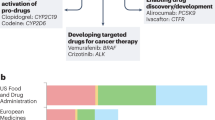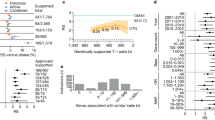Abstract
The potential medical applications of microarrays have generated much excitement, and some skepticism, within the biomedical community. Some researchers have suggested that within the decade microarrays will be routinely used in the selection, assessment, and quality control of the best drugs for pharmaceutical development, as well as for disease diagnosis and for monitoring desired and adverse outcomes of therapeutic interventions. Realizing this potential will be a challenge for the whole scientific community, as breakthroughs that show great promise at the bench often fail to meet the requirements of clinicians and regulatory scientists. The development of a cooperative framework among regulators, product sponsors, and technology experts will be essential for realizing the revolutionary promise that microarrays hold for drug development, regulatory science, medical practice and public health.
This is a preview of subscription content, access via your institution
Access options
Subscribe to this journal
Receive 12 print issues and online access
$209.00 per year
only $17.42 per issue
Buy this article
- Purchase on SpringerLink
- Instant access to full article PDF
Prices may be subject to local taxes which are calculated during checkout
Similar content being viewed by others
References
Warrington, J.A., Dee, S. & Trulson, M. Large-scale genomic analysis using Affymetrix GeneChipR probe arrays. in Microarray Biochip Technology (ed. Schena, M.) 119–148 (BioTechniques Books, Natick, MA, 2000).
Tefferi, A., Bolander, M.E., Ansell, S.M., Wieben, E.D. & Spelsberg, T.C. Primer on medical genomics part III: microarray experiments and data analysis. Mayo Clin. Proc. 77, 927–940 (2002).
Chee, M. et al. Accessing genetic information with high-density DNA arrays. Science 274, 610–614 (1996).
Cronin, M.T., Fucini, R.V., Kim, S.M., Masino, R.S., Wespi, R.M. & Miyada, C.G. Cystic fibrosis mutation detection by hybridization to light-generated DNA probe arrays. Hum. Mutat. 7, 244–255 (1996).
Hacia, J.G., Brody, L.C., Chee, M.S., Fodor, S.P.A. & Collins, F.S. Detection of heterzygous mutations in BRCA1 using high density oligonucleotide arrays and two-colour fluorescence analysis. Nature Genet. 14, 444–447 (1996).
Hacia, J.G. et al. Strategies for mutational analysis of the large multiexon ATM gene using high-density oligonucleotide arrays. Genome Res. 8, 1245–1258 (1998).
Favis, R. & Barany, F. Mutation detection in K-ras, BRCA1, BRCA2, and p53 using PCR/LDR and a universal DNA microarray. Ann. NY Acad. Sci. 906, 39–43 (2000).
Mei, R. et al. Genome-wide detection of allelic imbalance using human SNPs and high-density DNA arrays. Genome Res. 10, 1126–1137 (2000).
Cutler, D.J. et al. High-throughput variation detection and genotyping using microarrays. Genome Res. 11, 1913–1925 (2001).
Raitio, M. et al. Y-chromosomal SNPs in Finn-Ugric-speaking populations analyzed by minisequencing on microarrays. Genome Res. 11, 471–482 (2001).
Schena, M., Shalon, D., Davis, R.W. & Brown, P.O. Quantitative monitoring of gene expression patterns with a complementary DNA microarray. Science 270, 467–470 (1995).
Lockhart, D.J. et al. Expression monitoring by hybridization to high-density oligonucleotide arrays. Nature Biotech. 14, 1675–1680 (1996).
Shalon, D., Smith, S.J. & Brown, P.O. A DNA microarray system for analyzing complex DNA samples using two-color fluorescent probe hybridization. Genome Res. 6, 639–345 (1996).
Brown, P.O. & Botstein, D. Exploring the new world of the genome with DNA microarrays. Nature Genet. 21 (1 Suppl), 33–37 (1999).
DeRisi, J. et al. Use of a cDNA microarray to analyse gene expression patterns in human cancer. Nature Genet. 14, 457–460 (1996).
Golub, T.R. et al. Molecular classification of cancer: class discovery and class prediction by gene expression monitoring. Science 286, 531–537 (1999).
Bubendorf, L. et al. Hormone therapy failure in human prostate cancer: analysis by complementary DNA and tissue microarrays. J. Natl. Cancer Inst. 91, 1758–1764 (1999).
Alizadeh, A.A. et al. Distinct types of diffuse large B-cell lymphoma identified by gene expression profiling. Nature 403, 503–511 (2000).
Stamey, T.A. et al. Molecular genetic profiling of Gleason grade 4/5 prostate cancers compared to benign prostatic hyperplasia. J. Urology 166, 2171–2177 (2001).
Luo, J. et al. Human prostate cancer and benign prostatic hyperplasia: molecular dissection by gene expression profiling. Cancer Research 61, 4683–4688 (2001).
West, M. et al. Predicting the clinical status of human breast cancer by using gene expression profiles. Proc. Natl. Acad. Sci. USA 98, 11462–11467 (2001).
Hedenfalk, I. et al. Gene expression profiles in hereditary breast cancer. N. Engl. J. Med. 244, 539–548 (2001).
Shirota, Y., Kaneko, S., Honda, M., Hawai, H.F. & Kobayashi, K. Identification of differentially expressed genes in hepatocellular carcinoma with cDNA microarrays. Heptatology 33, 832–840 (2001).
Okabe, H. et al. Genome-wide analysis of gene expression in human hepatocellular carcinomas using cDNA microarray: identification of genes involved in viral carcinogenesis and tumor progression. Cancer Res. 61, 2129–2137 (2001).
van't Veer, L.J. et al. Gene expression profiling predicts clinical outcome of breast cancer. Nature 415, 530–536 (2002).
Rosenwald, A. et al. The use of molecular profiling to predict survival after chemotherapy for diffuse large-B-cell lymphoma. N. Engl. J. Med. 346, 1937–1947 (2002).
Shipp, M. et al. Diffuse large B-cell lymphoma outcome prediction by gene expression profiling and supervised machine learning. Nature Med. 8, 68–74 (2002).
Bittner, M. et al. Molecular classification of cutaneous malignant melanoma by gene expression profiling. Nature 406, 536–540 (2000).
Pomeroy, S.L. et al. Prediction of central nervous system embryonal tumour outcome based on gene expression. Nature 415, 436–442 (2002).
Armstrong, S.A. et al. MLL translocations specify a distinct gene expression profile that distinguishes a unique leukemia. Nature Genet. 30, 41–47 (2002).
Alevizos, I. et al. Oral cancer in vivo gene expression profiling assisted by laser capture microdissection and microarray analysis. Oncogene 20, 6196–6204 (2001).
Welsch, P.L. et al. BRCA1 transcriptionally regulates genes involved in breast tumorigenesis. Proc. Natl Acad. Sci. USA 99, 7560–7565 (2002).
Sreekumar, A. et al. Profiling of cancer cells using protein microarrays: discovery of novel radiation-regulated proteins. Cancer Res. 61, 7585–7593 (2001).
MacBeath, G. Proteomics comes to the surface. Nature Biotech. 19, 828–829 (2001).
Walter, G., Bussow, K., Lueking, A. & Glokler, J. High-throughput protein arrays: prospects for molecular diagnostics. Trends Mol. Med. 8, 250–253 (2002).
Kuruvilla, F.G., Shamji, A.F., Sternson, S.M., Hergenrother, P.J. & Schreiber, S.L. Dissecting glucose signalling with diversity-oriented synthesis and small-molecule microarrays. Nature 416, 653–657 (2002).
Paweletz, C.P. et al. Reverse phase protein microarrays which capture disease progression show activation of pro-survival pathways at the cancer invasion front. Oncogene 20, 1981–1989 (2001).
Torhorst, J. et al. Tissue microarrays for rapid linking of molecular changes to clinical endpoints. Am. J. Pathol. 159, 2249–2256 (2001).
Figeys, D. & Pinto, D. Proteomics on a chip: promising developments. Electrophoresis 22, 208–216 (2001).
Petricoin, E.F., Zoon, K.C., Kohn, E.C., Barrett, J.C. & Liotta, L.A. Clinical proteomics: translating benchside practice into bedside reality. Nature Rev. Drug Disc. 1, 663–686 (2002).
Eisen, M.B., Spellman, P.T., Brown, P.O. & Botstein, D. Cluster analysis and display of genome-wide expression patterns. Proc. Natl Acad. Sci. USA 95, 14863–14868 (1998).
Khan, J. et al. Classification and diagnostic prediction of cancers using gene expression profiling and artificial neural networks. Nature Med. 7, 673–679 (2001).
Petricoin, E.F. et al. Use of proteomic patterns in serum to identify ovarian cancer. Lancet 359, 572–577 (2002).
Roses, A.D. Genome-based pharmacogenetics and the pharmaceutical industry. Nature Rev. Drug Disc. 1, 541–548 (2002).
Seungchan, K. et al. Multivariate measurement of gene expression relationships. Genomics 67, 201–209 (2000).
Altman, R.B. & Klein, T.E. Challenges for biomedical informatics and pharmacogenomics. Ann. Rev. Pharm. Toxicol. 42, 113–133 (2002).
Lee, M.-L.T., Kuo, F.C., Whitmore, G.A. & Sklar, J. Importance of replication in microarray gene expression studies: statistical methods and evidence from repetitive cDNA hybridizations. Proc. Natl Acad. Sci. USA 97, 9834–9839 (2000).
Tseng, G.C., Oh, M.-K., Rohlin, L., Liao, J.C. & Wong, W.H. Issues in cDNA microarray analysis: quality filtering, channel normailization, models of variations and assessment of gene effects. Nucleic Acids Res. 29, 2549–2557 (2001).
Mills, J.C. & Gordon, J.I. A new approach for filtering noise from high-density oligonucleotide microarray datasets. Nucleic Acids Res. 29, e72 (2001).
Bakay, M., Chen, Y.-W., Borup, R., Zhao, P., Nagaraju, K. & Hoffman, E.P. Sources of variability and effect of experimental approach on expression profiling data interpretation. BMC Bioinformatics 3, 4 (2002).
King, H.C. & Sinha, A.A. Gene expression profile analysis by DNA microarrays: promise and pitfalls. JAMA 286, 2280–2288 (2001).
Nuwaysir, E.F., Bittner, M., Trent, J., Barrett, J.C. & Afshari, C.A. Microarrays and toxicology: the advent of toxicogenomics. Mol. Carcinogenesis 24, 153–159 (1999).
Waring, J.F. et al. Clustering of hepatotoxins based on mechanism of toxicity using gene expression profiles. Nature Genet. 29, 365–371 (2001).
Hamadeh, H.K. et al. Gene expression analysis reveals chemical-specific profiles. Toxicol. Sci. 67, 219–231 (2002).
Thomas, R.S. et al. Identification of toxicologically predictive gene sets using cDNA microarrays. Mol. Pharmacol. 60, 1189–1194 (2001).
Huang, Q. et al. Assessment of cisplatin-induced nephrotoxicity by microarray technology. Toxicol. Sci 63, 196–207 (2001).
Brown, P.O. & Hartwell, L. Genomics and human disease—variations on variation. Nature Genet. 18, 91–93 (1998).
He, B., Munson, A.E. & Meade, B.J. Analysis of gene expression induced by irritant and sensitizing chemicals using oligonucleotide arrays. Internat. Immunopharm. 1, 867–879 (2001).
Ramakrishnan, R. et al. An assessment of Motorola CodeLink™ microarray performance for gene expression profiling applications. Nucleic Acids Res. 30, e30 (2002).
Modrek, B. & Lee, C. A genomic view of alternative splicing. Nature Genet. 30, 13–19 (2002).
Brem, R.B., Yuert, G., Clinton, R. & Kruglyak, L. Genetic dissection of transcriptional regulation in budding yeast. Science 296, 752–755 (2002).
Cantor, C.R. Pharmacogenetics becomes pharmacogenomics: wake up and get ready. Mol. Diagnostics 4, 287–288 (1999).
Hamadeh, H.K., Bushel, P., Tucker, C.J., Martin, K., Paules, R. & Afshari, C.A. Detection of diluted gene expression alterations using cDNA arrays. Biotechniques 32, 322–329 (2002).
Stoeckert, C. et al. Microarray databases standards and ontologies. Nature Genet. 32, 469–473 (2002).
Brazma, A. et al. Minimal information about a microarray experiment (MIAME)—toward standards for microarray data. Nature Genet. 29, 365–371 (2001).
Author information
Authors and Affiliations
Corresponding authors
Ethics declarations
Competing interests
The authors declare no competing financial interests.
Rights and permissions
About this article
Cite this article
Petricoin, E., Hackett, J., Lesko, L. et al. Medical applications of microarray technologies: a regulatory science perspective. Nat Genet 32 (Suppl 4), 474–479 (2002). https://doi.org/10.1038/ng1029
Issue Date:
DOI: https://doi.org/10.1038/ng1029



